Filed under: General, Observations | Tags: Insects, Nature, Photography, Wagga, Wagga Wagga
This earlier post listed a few of the insect species found in the area. The present post is a continuation of that one.
—
Garden Praying Mantis (Orthodera ministralis)
A common and widespread mantid, Orthodera ministralis is often found (as its common name suggests) in suburban gardens. This individual was photographed on the South American potato vine Solanum jasminoides.
—
Tricolor Soldier Beetle (Chauliognathus tricolor)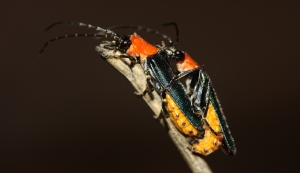
Breeding pairs of the Tricolor Soldier Beetle were commonly seen in late summer and early autumn. Other species of soldier beetle, C. lugubris and C. pulchellus, routinely form enormous breeding colonies, and so are often called Plague Soldier Beetles. See the Brisbane Insects website for more information.
This breeding pair was photographed on Willans Hill.
—
The Circulionidae (true weevils) is among the largest and most diverse of the insect families. It is often very difficult to identify particular species. This particular individual bears a very strong resemblance to the Elephant Weevil Orthorhinus cylindrirostris and may belong to the same subfamily (the Molytinae).
This individual was photographed on a Kurrajong (Brachychiton populneus), which seems to be a favourite foodsource of a couple of weevil species.
—
This is another weevil species, this time photographed in a suburban garden. The relatively short, broad rostrum (snout) suggests that this individual belongs to the subfamily Entiminae (broad-nosed weevils).
—
Pumpkin Beetles (Aulacophora hilaris)
This species of leaf beetle (Chrysomelidae) is common in vegetable gardens, particularly as a pest of cucurbits (in this case zucchini). They can be extremely destructive. This article from the Department of Primary Industries (now Industry & Investment and formerly NSW Agriculture) has some information on pests of cucurbits, including this species.
—
Green Garden Looper (Chrysodeixis sp.)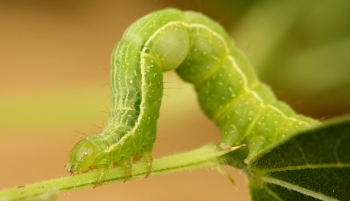
Chrysodeixis spp. are quite conspicuous – at least as caterpillars. The adults are not nearly as noticeable. As a leaf-eater with a taste for cultivated vegetables (this one was photographed on a bean plant) they can be quite destructive.
—
Banded Concealer Moth (Chrysonoma fascialis)
The Banded (or Purple-banded) Concealer Moth belongs to the family Oecophoridae (concealer moths), which is particularly well-represented around Wagga. Several other species are known from the area – some entirely white, some entirely yellow, some yellow with brownish or purplish markings. They are often found clinging to the underside of plant stems and leaves.
This individual was photographed on Willans Hill.
—
Two-lined Gum Treehopper (Eurymeloides bicincta) nymphs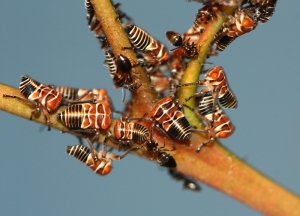
These are the nymphs of the Two-lined Gum Treehopper. The adults can be seen at the Brisbane Insects website. The young are attended by ants (in this case probably a species of Golden-tailed Sugar Ant Camponotus sp.) who collect from them a sugar secretion called honeydew. The ants essentially ‘farm’ the nymphs.
These individuals were photographed on Willans Hill.
—
Yellow-headed Leafhoppers (Brunotartessus fulvus)
Another species of hopper, also in the family Cicadellidae, though belonging to a different subfamily (Tartessinae, not Eurymelinae). Leafhoppers are plant-feeders, using their piercing mouthparts to extract sap from trees. These individuals were seen on a young eucalypt (possibly the River Red Gum Eucalyptus camaldulensis) near Lake Albert.
* * *
That’s all for now. In bird-related news, the Black-chinned Honeyeater (a vulnerable species) was recorded at Mates Gully Rd. TSR and has been added to the lists for Mates Gully and for Wagga Wagga. Also added to the Wagga list was the Swift Parrot, an endangered species, which was recorded (by call only) at Red Hill Reserve, near Pomingalarna. It is also known to overwinter in Mates Gully Rd. and Kyeamba TSRs.
In less encouraging news, the Scarlet Robin has recently been declared a vulnerable species (see here). Its numbers are apparently in decline. In the Wagga area it is known from Livingstone National Park and Mates Gully Rd. TSR.
Filed under: General, Observations | Tags: Birds, Insects, Photography, Wagga
An earlier post (Willans Hill in Summer, January 5) listed a number of insect species found in the Wagga area. The present post can be considered a continuation of that one. Where possible the insects illustrated have been identified to the level of species, but identification is not always straightforward. Of the many resources I have used, the Brisbane Insects website is probably the most useful (I take the blame for any incorrect identifications, of course).
This is likely to be the first of many posts on the insect fauna of the area.
Tailed Emperor Caterpillar (Polyura sempronius)
The Tailed Emperor is a large and beautiful butterfly in the family Nymphalidae. It is probably not a permanent resident here, but vagrants have been known to reach southern Victoria and south-eastern South Australia. The larva is pictured here on a Kurrajong (Brachychiton populneus), one of the species’ many larval foodsources, on Willans Hill. The “horns” are purely for intimidation: the caterpillar is completely harmless.
Privet Hawk Moth Caterpillar (Psilogramma menephron)
The larva of the Privet Hawk Moth is a large, robust and strikingly patterned caterpillar that – despite its name – is equally at home on a variety of introduced garden plants. The individual photographed was seen in a suburban garden, apparently feeding on the leaves of the Purple Trumpet Vine (Podranea ricasoliana), a South African import. Privet (Ligustrum spp.) is a significant garden escapee. Two species, L. sinense and L. vulgare, are declared noxious weeds in NSW.
Wasp Moth (Amata sp.)
Wasp Moths belong to the Ctenuchinae, a subfamily of the Arctiidae (Tiger Moths). There are a number of similar Amata species, which cannot be easily distinguished. A number of individuals were seen recently in Livingstone National Park.
Tiger Lichen Moth (Asura lydia)
The Tiger Lichen Moth is also a member of the Arctiidae, this time of the subfamily Lithosiinae (Lichen Moths). Once again, several individuals were seen in Livingstone.
Common Epicoma Moth (Epicoma melanosticta)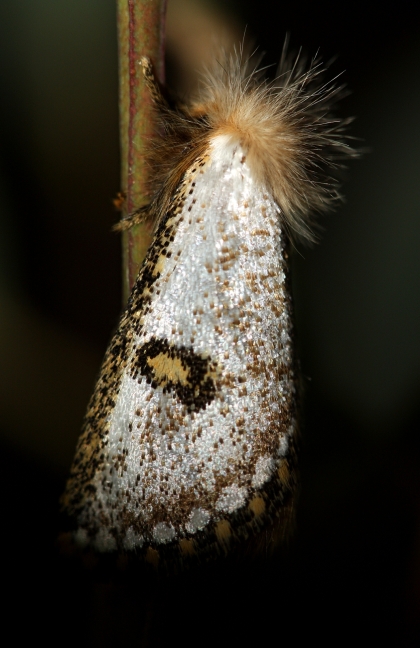
This stocky, distinctive moth was seen on Willans Hill and at Mundwaddery Cemetery. It belongs to the family Notodontidae. Its face is obscured by a dense mane of fibrous hairs:
Common Epicoma Moth (Epicoma melanosticta)
Diamond Beetle (Chrysolopus spectabilis)
The Diamond Beetle, also known as the Botany Bay Diamond Weevil, was the first Australian insect to be formally described. It is apparently very common around Sydney but is less so here.
Twentyeightspotted Ladybird (Epilachna vigintioctopunctata)
Most ladybird species are considered to be important control agents of crop and garden pests. The Twentyeightspotted Ladybird (also referred to as Epilachna 28-punctata and Epilachna cucurbitae), on the other hand, is a leaf-eater, and is also highly prolific. The larva is bizarre:
Twentyeightspotted Ladybird (Epilachna vigintioctopunctata)
A total of fourteen mature individuals were seen on a single zucchini plant.
Eucalyptus Leaf Beetle (Paropsis variolosa)
Paropsis variolosa resembles a large ladybird. It feeds exclusively on the leaves of Eucalyptus species. This individual was photographed on Willans Hill.
Longicorn Beetle (Family Cerambycidae)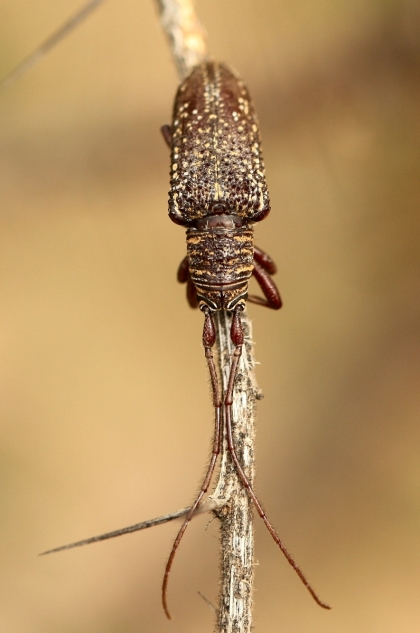
This Longicorn (“long-horned”) Beetle was photographed on a Kangaroo Thorn (Acacia paradoxa) shrub in Livingstone National Park. The precise identity of the beetle is uncertain, but it may be a species of Platyomopsis.
Green Potato Bug (Cuspicona simplex)![]()
The Green Potato Bug is – like the Twentyeightspotted Ladybird – a common resident of suburban gardens. It feeds on tomatoes, potatoes and other cultivated plants.
—
I have added the Black-Faced Woodswallow (Artamus cinereus) to the birdlist for Wagga Wagga. This brings the total number of species recorded over the past twelve months to 157, exactly 150 of which are native.
Filed under: Flora, General, Observations | Tags: Birds, Flora, Insects, Photography, Spiders, Wagga, Wildflowers
Leaden Flycatcher (Myiagra rubecula) in Murraguldrie Flora Reserve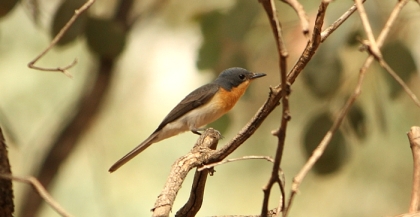
Murraguldrie Flora Reserve is located around 45km southeast of Wagga on the Tumbarumba Rd., which separates it from Murraguldrie State Forest proper. The Flora Reserve was established to protect the only known population (a few hundred mature specimens) of the bush-pea Pultenaea humilis in NSW. It is a wetter forest than is usually found in the area and this is reflected in the health and density of the vegetation and the large populations of bryophytes (mosses and liverworts) found there.
There are other signs of a slightly different microclimate. Vanilla Lilies (Arthropodium milleflorum) and Chocolate Lilies (Dichopogon strictus), which typically flower in late spring, remained in flower in the reserve in mid-January.
Chocolate Lily (Dichopogon strictus)
Vanilla Lily (Arthropodium milleflorum)
Most of the reserve consists of eucalypts – including the Inland Scribbly Gum (Eucalyptus rossii) – with a heathy understorey. Among the wildflowers found in the reserve are the Small St. John’s Wort (Hypericum gramineum) and several species of goodenia.
Small St. John's Wort (Hypericum gramineum)
Note: Hypericum gramineum should be distinguished from the much larger Hypericum perforatum, which is a noxious weed. At least one other major weed – the Blackberry (Rubus sp.) – is found in the reserve.
Cassinias, a group of flowering natives with a tendency to spread, are also found in the reserve – principally along roadsides.
There is likely to be a substantial insect and arachnid population in the reserve as well. The following photographs show a selection of the more conspicuous species.
Orb-Weaving Spider (Possibly Eriophora or Araneus sp.)
A list of bird species recorded in the reserve so far can be found here. (Note that this was compiled from very few visits and is likely to grow in the future). The most interesting species on the list are the White-Throated Gerygone (Gerygone olivacea) and the Olive-Backed Oriole (Oriolus sagittatus), neither of which has been recorded elsewhere in the region. The Brown Treecreeper (Climacteris picumnis), listed as vulnerable in NSW, is also a significant find.
Filed under: General, Observations | Tags: Birds, Insects, Photography, Spiders, Wagga
Young Southern Boobooks (Ninox novaeseelandiae)
There was an article in the Daily Advertiser yesterday about a family of five Southern Boobooks (Ninox novaeseelandiae) that had taken up residence in a suburban backyard. Boobooks seem to be rather more content in residential areas than other owl species: another family has found a home on Willans Hill. The two photographed above are juveniles (too young to have learned the famous ‘boobook’ call, instead making insect-like trills). Two other owls were seen nearby, at least one of which was an adult.
—
Yellow Owl-Fly (Suhpalacsa flavipes)
The Yellow Owl-Fly (Suhpalacsa flavipes) is so named, I suppose, for its enormous eyes. They are not especially nocturnal, though the individual above was photographed late in the evening.
I spotted one for the first time shortly after posting the previous entry, which lists many of the insect species found on the hill. This is one more for the already lengthy list.
—
Alright, so it’s not an actual wolf:
Wolf Spider (Family Lycosidae)
The Wolf Spiders (family Lycosidae) dig very neat, circular burrows in which they spend much of their time. I can’t identify the above to the level of species, but the most common of the Wolf Spiders is the Garden Wolf Spider (Lycosa godeffroyi).
Filed under: Flora, General, Lists, Observations | Tags: Birds, Butterflies, Flora, Grasses, Insects, Nature, Photography, Spiders, Wagga, Wildflowers
I have added the White-throated Gerygone (Gerygone olivacea) and the Dollarbird (Eurystomus orientalis) to the Wagga list. The former species was recorded in Murraguldrie Flora Reserve, a short distance south-east of Wagga. Birdata gives the impression that it is rarely seen any further west. The Dollarbird, on the other hand, is probably a regular, if uncommon, summer migrant to the area.
—
[NOTE: Click on the red text to view photographs].
Summer is now well and truly here and few wildflowers remain in bloom on Willans Hill. The heavy rains in mid-December encouraged a few of the more opportunistic species (Calotis spp., Vittadinia spp.) to put out new flowers, but even these are disappearing. A few Sticky Everlastings (Xerochrysum viscosum) remain, but most have gone to seed. Those bluebells (Wahlenbergia spp.) that remain will likely be gone within a few weeks. A single flowering plant of the summer-blooming Yellow Rush Lily (Tricoryne simplex) has been located; I would expect others to be present.
Common Wheat Grass (Elymus scaber)
At present the hill’s understorey is comprised largely of native grasses, including Spear Grasses (Austrostipa spp.), Wire Grasses (Aristida spp.), Wallaby Grasses (Austrodanthonia spp.) and Common Wheat Grass (Elymus scaber). A few dry tussock grasses may be native Poa species. Redgrasses (Bothriochloa machra and Bothriochloa decipiens), Windmill Grass (Chloris truncata), Common Blown-Grass (Lachnagrostis filiformis) and Hairy Panic (Panicum effusum), all natives, are also found on the hill, but principally in the more settled areas.
Kurrajong (Brachychiton populneus)
Many birds, including Grey Fantails (Rhipidura albiscapa) and Rufous Whistlers (Pachycephala rufiventris) are still to be seen with dependent young. Other young birds, such as this robin (probably a Red-Capped Robin), are starting to become semi-independent. At present the hill’s bird fauna is chiefly comprised of small insectivores (Weebills, Yellow and Yellow-Rumped Thornbills, Western Gerygones, the aforementioned Grey Fantails and Rufous Whistlers) — not surprising given the increasing insect population of the area. Probably most of the smaller insect species spend much of their time concealed in debris or under bark, but others can be seen gathered around the flowers of the Kurrajong tree (above). The Kurrajong, specimens of which are scattered across the hill, is a native, but is never the dominant species in natural woodlands. It is popular today in avenues and windbreaks, and has some value as a source of fodder in times of scarcity.
Grasshoppers (like this one and this one) are among the most numerous (and diverse) of the insects to be found on the hill at present, but there are also many wasps (Ichneumonids, Gasteruptiids, Braconids, Pompilids, and so on), flies (House Flies and Bush Flies, of course, but also Blowflies, Drone Flies, Hoverflies, Robber Flies, Flesh Flies, Bee Flies, and Tachinids [chiefly Rutilia sp.]), and beetles (Scarab Beetles, Christmas Beetles, Weevils, Belid Weevils, Pollen Beetles, Jewel Beetles, and, of course, Ladybirds).There are crickets, cicadas, leafhoppers, coreids (including the Eucalyptus Tip or Clown Bugs, Amorbus spp.), alydids, scorpionflies, native cockroachs (chiefly Ellipsidion australe and Ellipsidion humerale), antlions, lacewings, ants of various kinds, many insects too small to be noticed (though the tiny Rutherglen Bug [Nysius vinitor] forms breeding swarms so large as to be unmissable), and many others beyond my capacity to identify. Moths are well represented, as well. The most common are Oecophorids (including Eochrois spp. and Crepidosceles spp.) and Noctuids (including the Bogong Moth [Agrotis infusa] and the pest species Helicoverpa armigera). Geometrids and Cossids are seen reasonably frequently, also. The moths are so diverse they may warrant a series of their own.
Dainty (or Dingy) Swallowtail (Papilio anactus)
The most conspicuous insects are, of course, the dragonflies and butterflies. The following 14 species of butterfly have so far been recorded on the hill: Australian Painted Lady (Vanessa kershawi), Cabbage White (*Pieris rapae), Caper White (Belenois java), Chequered Copper (Lucia limbaria), Common Brown (Heteronympha merope), Common Grass-Blue (Zizina labradus), Dainty Swallowtail (Papilio anactus, above), Greenish Grass-Dart (Ocybadistes walkeri, below), Lesser Wanderer (Danaus chrysippus), Meadow Argus (Junonia villida), Saltbush Blue (Theclinesthes serpentata), Spotted Jezebel (Delias aganippe), Two-Spotted Line-Blue (Nacaduba biocellata), Yellow Admiral (Vanessa itea). The Small Grass-Yellow (Eurema smilax) is known to occur in the Wagga area (having been recorded at Silvalite Reserve) and several others are predeicted to occur here. The most common butterfly is the tiny Common Grass-Blue, which is often seen in numbers in lawns and around flowering plants. The larger butterflies seem to alternate in frequency, with one species dominating for a time and then being being usurped by another. At present the Common Brown is the most commonly encountered, but earlier in the season it was the Caper White and before that the Australian Painted Lady. The introduced Cabbage White has remained relatively common throughout the season.
Greenish Grass-Dart (Ocybadistes walkeri)
Only one member of the Skipper family (Hesperiidae) has been recorded here, the Greenish Grass-Dart. Other species can be found further east.
Spiders are also common on the hill at present, presumably taking advantage of the large number of small insects. Among the more common are the Garden Orb-Weaver (Eriophora transmarina), the Golden Orb-Weavers (Nephila spp.), the Common (or Bug-Mimicking) Swift Spider (Supunna picta), the Garden Wolf Spider (Lycosa godeffroyi), several Huntsman Spiders (family Heteropodidae), a number of Lynx Spiders (family Oxyopidae), Crab Spiders (family Thomisidae), Flower Spiders (Diaea spp.), and many Jumping Spiders (family Salticidae). Many of the spiders associated with human settlement – including the Black House Spider (Badumna insignis), White-Tailed Spider (Lampona cylindrata), the Daddy Long-Legs (Pholcus phalangioides) and the well-known, if not well-liked, Redback Spider (Latrodectus hasselti) – can be found on the hill. There’s also the occasional oddity.
—
That’ll do for now. I hope to post entries on Murraguldrie Flora Reserve and the Mates Gully Rd Travelling Stock Reserve soon.










